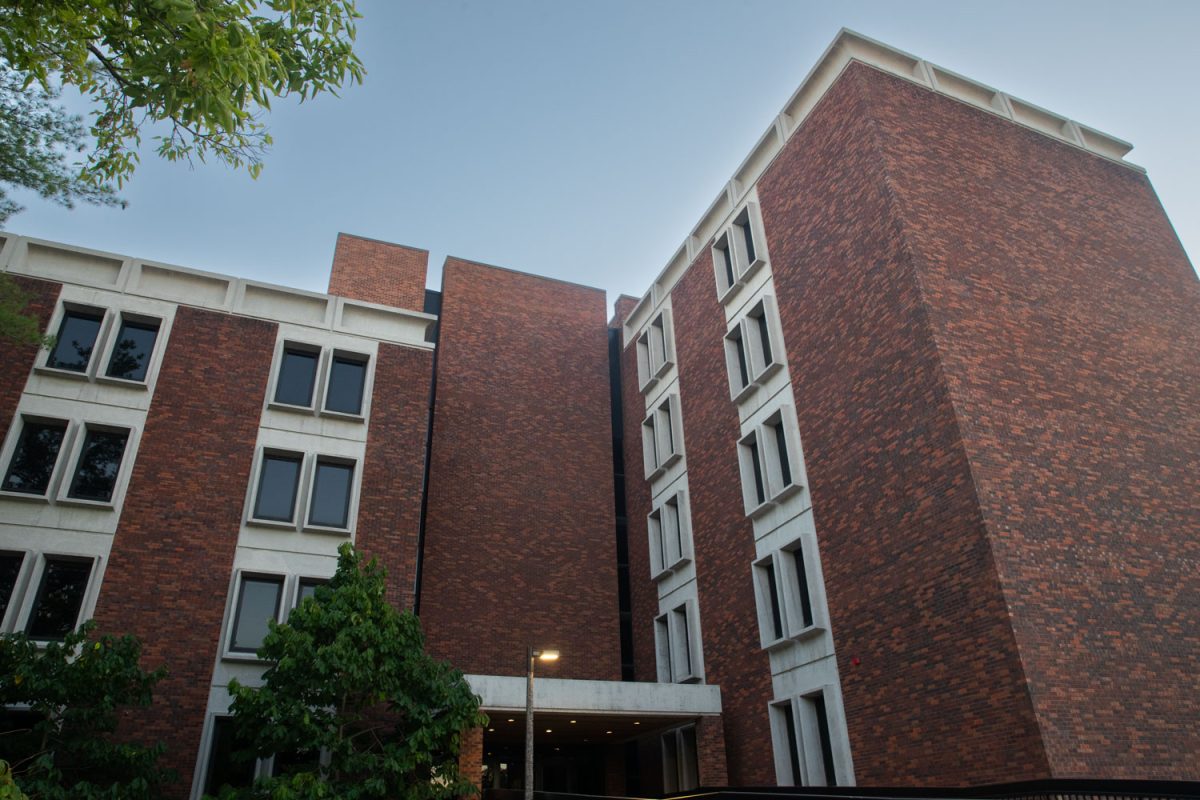For those unfamiliar with Brutalism, the origin of the word has been traced back to the French “béton brut,” meaning “raw concrete.”
Brutalist architecture first emerged in the 1950s in the United Kingdom as an offshoot of modernism. The goal was to create buildings using limited resources and materials to aid reconstruction efforts following World War II.
Raw materials such as concrete and exposed metal were used not only for affordability but also to highlight the simplistic and “honest” expression of the selected substances. Historically, the building type features straight geometric forms reminiscent of giant concrete cinder blocks.
This type of architectural style didn’t reach the U.S. until the early 1960s, creeping its way onto college campuses in the following decades. The modern notion is that most university campuses in the U.S. likely have at least one building resembling Brutalist design.
Examples you may recognize on the University of Iowa campus include Phillips Hall, the College of Nursing, and even the Main Library.
Despite the architectural style once being sensible and affordable, these buildings have overstayed their welcome on college campuses. Now, they remind students of the uncreative, drab, and rigid coursework often associated with higher education.
Iowa’s campus design should reflect the values of today’s students. Brutalist-style buildings should be torn down or renovated to enhance campus facilities and engage students in nontraditional ways, ensuring that curiosity and creativity flourish through a focus on design and culture.
Many people associate Brutalist architecture with dark, depressing, and sinister origins, largely due to popular culture and historical design. These associations likely stem from social institutions like bunkers and prisons, which often feature Brutalist design and carry negative cultural connotations.
This same notion is carried on by UI senior Ethan Umina, who, when asked about the Brutalist style English-Philosophy Building, said, “If the goal was to build a place that made everyone inside depressed, then it’s doing its job perfectly.”
This is just one of many student opinions that reflect the general consensus about many of the Brutalist buildings on campus.
Moreover, whether this distaste is warranted or not, public perception is typically hard to reshape. Despite the practical design choices of these buildings, they evoke a sense of uncertainty and complacency in passersby.
Brutalist architecture incorporates rigid structural elements and a lack of color, which can subconsciously stifle originality. This mindset should have no place on college campuses, especially when students are developing a sense of ingenuity and individualism.
According to former University of Toronto Chief of Planning, Design, and Construction Gilbert Delgado, campus design and architecture are essential because they enable students to focus on ideas beyond their given major.
The design and beautification of campuses should also be based on longevity, not merely a return on investment. Simply put, students should feel that their financial investment and possible relocation are worthwhile. Higher education is a business, but its sole focus shouldn’t be for universities to make money. Students need to feel supported in their academic goals and represented in all aspects of campus life.
Creativity, free thinking, and taking lessons beyond the classroom from real-life experiences is what college is all about. Recognizing beauty and applying it to an academic setting, especially outside one’s major, is crucial for all students. Despite what many critics have claimed, Brutalist architecture greatly inhibits students from doing so.
When the UI’s master construction and design plan was presented in January of 2022, there was little emphasis on renovating Brutalist buildings on campus. The only proposed renovation is for the Performing Arts Annex, which now holds the UI Department of Dance and other performing arts classrooms and spaces.
The plan excluded buildings like Phillips Hall and the English-Philosophy Building, which are outdated both internally and externally.
“The EPB was built over 50 years ago, and its design reflects that. It is a functional building but pretty dated,” Barb Pooley, the primary building coordinator for the English-Philosophy Building, said.
Pooley also commented on the current needs of the EPB.
“We don’t have any spaces – other than hallways – where students can sit and work or listen to online classes,” Pooley said.
Another item on the wish list? A new HVAC system.
The current system is original to the EPB and has trouble keeping the building comfortable, especially on hot, humid days. To combat this, dehumidifying units have been installed on each floor. However, because they run constantly, they’re known to distract students.
Seeing as the building is close to 60 years old, these requests seem reasonable. Not to mention, the EPB houses classes for many of the UI’s programs, including rhetoric, which is a required course for all undergraduate students.
According to the UI Design Standards and Procedures, when a building is deemed to require renovations, a code must be upheld.
“Universal Design is defined as a process that enables and empowers a diverse population by improving human performance, health and wellness, and social participation,” the standards state.
The irony behind this “standard” is that many of the proposed renovations in the 10-Year University Facilities Master Plan don’t make life “easier, healthier, or friendlier for all.”
There hasn’t been an emphasis on updating buildings for accessibility, nor creating a more friendly and engaging exterior for students. These hold-ups have historically been associated with older buildings on campus, some of which are designed in the Brutalist style.
Both Phillips Hall and the EPB only offer two accessible entrances. Compare that to buildings like Adler, which only features accessible entrances. Shouldn’t all students have the same access to learning environments?
This lack of accessibility and adaptiveness demonstrates the shortsightedness of the current administration, as well as a reluctance to better the life of students on campus, which I contend should be priority number one.
In this new age of technology and innovation, Brutalist architecture should be banned on college campuses. Universities can be catalysts for change and independent thought. It’s more than fair to expect their campuses to reflect that promise.



